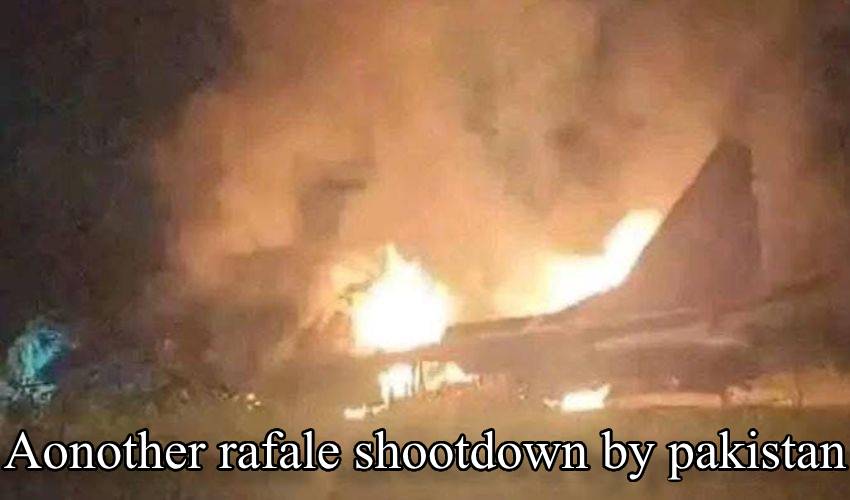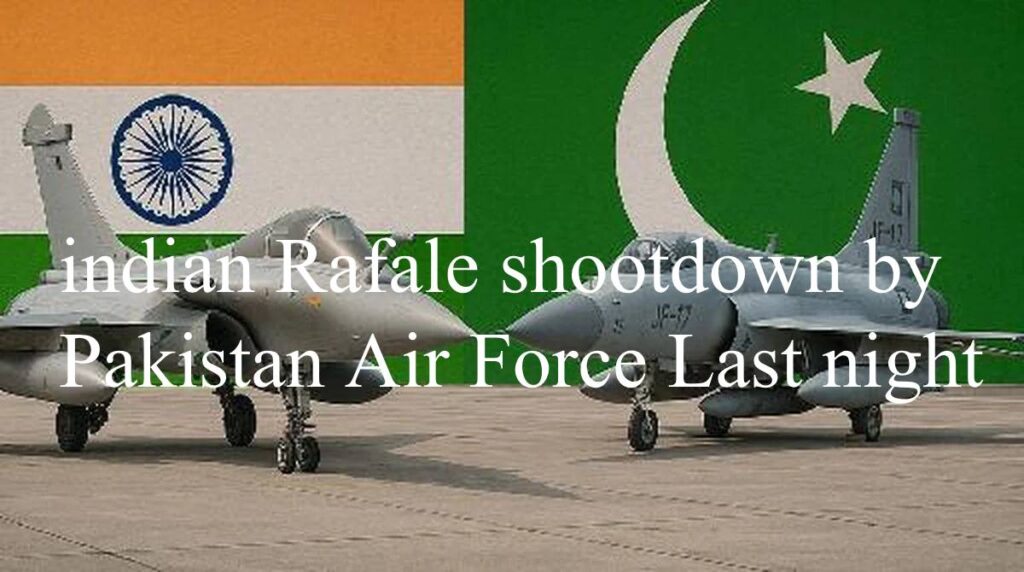“Pakistan shot down an Indian Rafale jet using Chinese-made J-10 fighters, U.S. officials confirm. BBC verifies crash footage from Bathinda amid escalating India-Pakistan air conflict.”
Tensions between India and Pakistan have taken a dramatic turn, with reports emerging that Pakistan used Chinese-made J-10 fighter jets to shoot down Indian Air Force (IAF) planes, including at least one French-made Rafale aircraft. The aerial confrontation, which followed Indian airstrikes inside Pakistani territory earlier this week, has alarmed military observers worldwide and raised concerns about further escalation between the nuclear-armed neighbors.
According to multiple international news agencies, including CNN, BBC, and Reuters, the incident marks one of the most significant air combat encounters in South Asia since the 2019 Pulwama-Balakot standoff. The developments come amid a rapidly deteriorating security situation along the India-Pakistan border, particularly after an April 22 attack in Indian-administered Kashmir that New Delhi blamed on Pakistan-based militants.
Table of Contents
US Officials Confirm Pakistan Shot Down Indian Fighter Jets
In an exclusive report on Thursday, CNN cited a senior U.S. official confirming that, based on American intelligence assessments, Pakistan successfully shot down at least one Indian Rafale jet during Wednesday’s air engagements. The source stated that the Pakistani Air Force (PAF) used advanced Chinese-built J-10C multirole fighters to intercept and strike Indian aircraft operating in or near Pakistani airspace.
Reuters also reported similar findings, quoting two U.S. defense officials who corroborated the use of air-to-air missiles launched from J-10 fighters in combat operations that resulted in Indian losses.
One American official, speaking on condition of anonymity, stated:
“There is a high level of confidence that the Pakistani Air Force launched Chinese-made air-to-air missiles at Indian fighter jets, resulting in successful takedowns.”
The other official confirmed that one of the downed jets was a Rafale, a key component of India’s next-generation air combat fleet.
Pakistan Claims It Shot Down Five Indian Jets, Including Three Rafales
On Wednesday, Pakistan’s military declared that it had shot down five Indian Air Force jets, including three Rafales. The Pakistani government released an official statement saying their defensive action was in response to Indian incursions targeting locations inside Pakistani territory earlier that day.
The statement read:
“The Pakistan Air Force responded decisively to Indian aggression, neutralizing five incoming fighter aircraft using precision-guided systems. Our air defense network remains on high alert.”
As of Friday morning, Indian officials have not confirmed or denied the Pakistani claim. In a press briefing, Indian Foreign Secretary Vikram Misri was evasive when directly asked about the aircraft losses. He responded:
“Appropriate information will be released at the right time. Right now, our focus is on national security operations and safeguarding lives.”
This ambiguity has only fueled speculation, as footage and eyewitness reports from various parts of India begin to surface online.

BBC Verifies Wreckage of Indian Rafale in Bathinda
Adding further weight to the Pakistani claim, the BBC’s investigative unit “BBC Verify” confirmed the authenticity of video footage showing the wreckage of a Rafale jet in Bathinda, a city in the Indian state of Punjab. The footage, widely circulated on social media and verified using geolocation tools, showed Indian military personnel retrieving debris from a large open field.
According to BBC analysts, three separate video clips were verified:
- A daytime video showing the charred remains of an aircraft, with Indian Army soldiers collecting parts and sealing off the area.
- A nighttime video capturing a projectile catching fire mid-air, followed by an explosion in an open field.
- A clip showing debris scattered over farmland near Bathinda, later confirmed by satellite imagery and metadata analysis.
Justin Crump, a former British Army officer and military analyst, confirmed to the BBC that visible parts of the wreckage were consistent with air-to-air missiles used on both Rafale and Mirage 2000 aircraft.
“The structure, engine parts, and markings in the video suggest it was indeed a Rafale or a similar French-designed aircraft,” Crump said. “The missile remains seem to belong to the MBDA MICA system, commonly deployed on Indian Rafales.”
The Rafale vs. J-10: A New Era of Air Combat in South Asia?
The Dassault Rafale, a 4.5-generation fighter jet developed by France, is considered one of the most advanced aircraft in the Indian Air Force. India finalized a €7.8 billion deal with France in 2016 for 36 Rafales, receiving its final batch in 2022. Equipped with cutting-edge avionics, radar systems, and weapons like Meteor and MICA missiles, the Rafale was intended to provide India with air superiority over regional adversaries.
On the other hand, the J-10C Vigorous Dragon, a Chinese multirole fighter jet, has gained attention for its modern radar systems, fly-by-wire technology, and long-range missile capabilities. Pakistan inducted the first batch of J-10Cs into its air fleet in 2022 as part of deepening defense cooperation with China.
Military experts are now drawing comparisons between the two platforms, with many surprised at Pakistan’s apparent success in countering India’s advanced Rafales. This could signify a significant shift in the regional air power balance.
Political Silence in New Delhi Raises Questions
While Pakistan has taken a bold public stance, India’s political leadership has remained largely silent on the matter. Analysts suggest that the government is weighing its options carefully, not wanting to confirm aircraft losses publicly while assessing damage and diplomatic repercussions.
Opposition leaders and defense analysts within India have begun demanding transparency, urging the Ministry of Defence to issue a statement and clarify the status of the Indian Air Force pilots and jets.
Retired Air Marshal R.K. Sharma told local media:
“We need facts. If a Rafale has been shot down, this represents not just a tactical loss but also a strategic vulnerability. The government must brief the nation.”

Civilian Impact and Regional Fallout
Meanwhile, the civilian population in border regions continues to suffer amid escalating military tensions. Villages in Punjab, Kashmir, and northern Pakistan have reported artillery shelling, drone sightings, and disruption of essential services. At least 48 deaths have been confirmed in the broader conflict since India initiated strikes on May 7, including non-combatant casualties on both sides.
International human rights organizations have called for an immediate ceasefire and humanitarian corridors to evacuate civilians trapped in high-conflict areas.
Global Reactions and Diplomatic Warnings
As the situation escalates, global powers have begun weighing in. The United Nations, United States, and European Union have all issued statements urging India and Pakistan to exercise restraint and avoid further military engagement.
China, while not publicly celebrating the use of its J-10 jets, expressed “serious concern” over rising instability in South Asia. It called for a “measured response and peaceful dialogue”, although it has refrained from criticizing Pakistan’s actions directly.
U.S. State Department officials have reportedly reached out to both New Delhi and Islamabad, encouraging the resumption of diplomatic channels and proposing a third-party mediation option.
Conclusion: A New Chapter in Indo-Pak Military Confrontation?
The confirmed downing of a Rafale jet marks a critical moment in South Asian military history, illustrating how regional dynamics are shifting with newer alliances and emerging technologies. The fact that Pakistan may have succeeded in downing India’s prized French fighter using Chinese weaponry could trigger significant changes in India’s air defense doctrine and acquisition strategy.
As the world watches closely, one thing is clear: the potential for further escalation remains dangerously high. Unless diplomatic solutions emerge swiftly, the India-Pakistan conflict may be on the brink of entering a more advanced and unpredictable phase.




